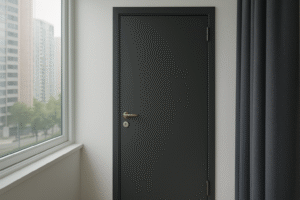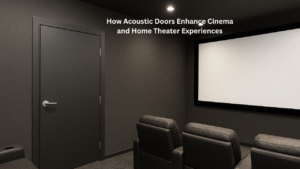Learn the Real Difference Between an Anechoic Chamber and a Soundproof Room
When it comes to controlling sound, two terms often come up: Anechoic Chamber and Soundproof Room. At first glance, they might seem similar since both are designed to control noise and create quieter environments. However, the purpose, design, and acoustic performance of these two spaces are very different.
In this comprehensive guide, we’ll break down what makes an Acoustic Anechoic Chamber different from a soundproof room, how each one works, their uses, pros and cons, and which one might be best for your project. Whether you’re an engineer, musician, researcher, or simply someone curious about sound control, this post will help you understand the difference clearly.
Anechoic Chamber Measurements are essential for precise sound testing by eliminating external noise and reflections. The chamber is designed with a metal mesh or suspended grid floor to prevent reflections, and its structure is isolated from vibrations and external sounds using floating floors, double walls, and insulated ceilings. This setup ensures accurate acoustic measurements for industries like audio engineering and telecommunications
What Is an Anechoic Chamber?
An anechoic chamber is a specially designed room that completely absorbs sound waves and blocks all external noise. The word anechoic literally means “without echo.” Inside an anechoic chamber, you’ll experience an eerie sense of silence so quiet that you can even hear your own heartbeat, breathing, or the sound of your joints moving.
How It Works
The interior surfaces of a semi-anechoic chamber are covered with sound-absorbing wedges, typically constructed from materials like fiberglass, mineral wool, or foam. These wedges are strategically shaped and positioned to capture and absorb sound energy, ensuring it doesn’t reflect.
The floor is often made of a metal mesh or suspended grid to avoid reflections from beneath. The entire structure is also isolated from vibrations and external sounds using floating floors, double walls, and insulated ceilings.
This design ensures that:
- There are no sound reflections (no echo or reverb).
- No external noise enters the chamber.
- The interior space represents a free-field condition, where sound behaves as if it’s traveling in open air.
What Is It Used For?
Anechoic chambers are not meant for everyday use. They are scientific and industrial tools used for precise sound measurement and research. Common uses include:
- Acoustic Testing:
Manufacturers test the sound output of devices such as speakers, microphones, headphones, and fans. The chamber provides a perfect environment to measure how sound behaves without interference. - Electromagnetic Testing:
Some chambers are designed to absorb radio waves instead of sound. These are used to test antennas, radar systems, and wireless communication devices. - Hearing Research:
Scientists use anechoic chambers to study human hearing, speech perception, and auditory responses under controlled conditions. - Product Noise Evaluation:
Companies test machinery, automotive components, or appliances to determine how much noise they produce and how to reduce it. - Psychoacoustic Experiments:
Researchers analyze how people perceive silence or sound in a completely echo-free space.
Experience Inside an Anechoic Chamber
Entering a full anechoic chamber is a surreal experience. With no sound reflections or external noise, your brain has difficulty adjusting. Many people find it disorienting or uncomfortable after just a few minutes, which is why visits are typically brief.
The quietest anechoic chamber in the world, located at Microsoft’s headquarters, records an ambient noise level of -20.6 decibels (dB), which is below the threshold of human hearing.
What Is a Soundproof Room?
A soundproof room is designed to block or isolate sound, preventing it from entering or leaving the space. Unlike anechoic chambers, soundproof rooms do not aim to absorb all reflections. Instead, they focus on containment.
How It Works
Soundproofing works on the principles of:
- Mass: Heavier materials block sound better.
- Damping: Materials that reduce vibration prevent sound transfer.
- Decoupling: Separating structures (like walls or ceilings) reduces vibration paths.
- Sealing: Tight seals around doors, windows, and vents prevent sound leaks.
Common soundproofing materials include:
- Mass Loaded Vinyl (MLV)
- Acoustic insulation
- Resilient channels
- Double-glazed windows
- Soundproof doors and seals
Where Are Soundproof Rooms Used?
Soundproofing is widely used in both commercial and residential spaces. Here are a few examples:
- Recording Studios:
To ensure that no outside noise interferes with recording sessions and that the sound inside doesn’t leak out. - Home Theaters:
To create a high-quality audio experience without disturbing other rooms. - Offices and Meeting Rooms:
To maintain privacy during important discussions and reduce distractions from external sounds. - Hospitals and Laboratories:
To maintain quiet environments for sensitive tests or patient recovery. - Industrial Applications:
To contain noise from heavy machinery, generators, or HVAC systems.
Anechoic Chamber vs Soundproof Room: Key Differences
Though both spaces are designed with sound control in mind, they serve completely different purposes. Let’s look at the major differences:
| Feature | Anechoic Chamber | Soundproof Room |
| Primary Goal | Absorbs all sound reflections for pure silence | Blocks sound from entering or leaving |
| Noise Level Inside | Near 0 dB (completely silent) | Quiet, but not echo-free |
| Wall Design | Covered with sound-absorbing wedges | Heavy and dense, often with insulation |
| Acoustic Behavior | Free-field (no echo or reverberation) | Controlled reverberation but not eliminated |
| Applications | Research, acoustic testing, and hearing studies | Recording studios, offices, homes |
| Cost | Very expensive | Moderate to high |
| Comfort Level | Not comfortable for long stays | Comfortable for daily use |
Understanding the Science Behind Each
How an Anechoic Chamber Controls Sound
Anechoic chambers use sound absorption to prevent echoes. When sound hits the wedge-shaped foam, it gets trapped and converted into heat energy. Because of this, sound waves can’t bounce back, creating a space that behaves like an infinite open field.
The structure also includes:
- Multiple layers of dense insulation to block outside noise.
- Suspended floors to prevent vibrations from the ground.
- Precision calibration for acoustic uniformity.
How a Soundproof Room Blocks Noise
Soundproof rooms use mass and isolation to stop sound transmission. The thicker and denser the barrier, the less sound can pass through. In some cases, two walls or ceilings are built separately (a technique called decoupling) to stop vibrations from traveling between surfaces.
Instead of total silence, a soundproof room creates a controlled acoustic environment that is ideal for recording, working, or resting.
Advantages and Disadvantages
Advantages of Anechoic Chambers
- Perfect for scientific testing and precise sound measurement.
- Provides accurate acoustic data with zero interference.
- Ideal for product development in the audio and electronics industries.
Disadvantages:
- Extremely expensive to build and maintain.
- Not suitable for long human occupancy.
- Requires specialized expertise for construction and calibration.
Advantages of Soundproof Rooms
- Practical and affordable for everyday use.
- Enhances privacy and comfort in homes and offices.
- Ideal for recording, meetings, and entertainment.
Disadvantages:
- Does not eliminate echoes.
- Some sound may still transfer if the room isn’t properly sealed.
- Quality varies based on materials and installation.
Choosing the Right Option for Your Needs
When to Choose an Anechoic Chamber
- You’re conducting acoustic or vibration testing.
- You need precise sound measurements for research or manufacturing.
- Your work involves developing sound equipment like microphones, sensors, or engines.
Example:
A speaker manufacturer testing sound output and directionality needs an anechoic chamber to eliminate external interference.
When to Choose a Soundproof Room
- You want to record music, podcasts, or videos without background noise.
- You’re creating a private workspace or meeting room.
- You need to reduce industrial noise for safety or compliance.
Example:
A home studio owner uses soundproofing to block outside traffic noise and prevent music from disturbing neighbors.
Cost Comparison
| Aspect | Anechoic Chamber | Soundproof Room |
| Average Cost | ₹40 lakh – ₹2 crore (or more) | ₹1 lakh – ₹10 lakh (varies by size and materials) |
| Maintenance | High (requires calibration) | Low to moderate |
| Construction Time | Several months | A few weeks |
| Customization | Highly specific | Flexible and scalable |
Anechoic chambers are an investment for research and manufacturing, whereas soundproof rooms are a practical choice for everyday noise control.
Anechoic Chamber and Acoustic Solutions by Ecotone Systems
If you are looking for a trusted partner for anechoic chambers or other soundproofing solutions, Ecotone Systems is one of the leading acoustic solution providers in India. With years of experience in noise control and acoustic design, Ecotone Systems delivers high-quality, customized solutions for a wide range of industries, including automotive, electronics, architecture, and research.
Expertise in Anechoic Chambers
Ecotone Systems specializes in the design, manufacturing, and installation of both anechoic and semi-anechoic chambers.
These chambers are built to eliminate reflections and external noise, creating an environment where accurate sound measurements and product testing can take place. Whether you need a chamber for loudspeaker testing, microphone calibration, or automotive acoustic research, Ecotone Systems provides tailor-made designs that meet international acoustic standards such as ISO and ANSI.
Wide Range of Acoustic Solutions
In addition to anechoic chambers, Ecotone Systems provides a variety of acoustic and noise control services to meet different industry needs. These include:
- Building Acoustics
Designing spaces such as offices, studios, classrooms, and auditoriums to enhance sound clarity and reduce unwanted noise. - Acoustic Louvers
Specially designed louvers that allow ventilation while minimizing sound transmission, suitable for industrial and commercial environments. - Noise Barriers
Durable barriers that effectively reduce or block noise from highways, factories, and construction sites.
Each solution is crafted using high-quality materials and precision engineering to ensure long-lasting performance and effective noise reduction across a wide range of applications.
Conclusion
Understanding the difference between an anechoic chamber and a soundproof room is essential for anyone looking to control sound effectively. Anechoic chambers are designed for precision testing and research, providing an environment free from echoes and external noise. Soundproof rooms, on the other hand, focus on blocking unwanted noise and creating quiet, comfortable spaces for recording, offices, or homes. Choosing the right solution depends on your specific needs, budget, and the level of acoustic control required. Companies like Ecotone Systems offer expert design, installation, and a range of acoustic solutions to help you achieve optimal sound performance, whether for professional testing, industrial applications, or everyday soundproofing.





